Peckham was appointed deacon of Westminster’s First Congregational Church in 1828, a post he would hold for 14 years. He retained the title of deacon throughout his life, even during years of controversy and estrangement from his church stemming from disagreement among the members concerning the extent of their participation in abolitionist activities. Peckham was deeply committed to the cause. According to his youngest daughter, the deacon’s home served as part of the Underground Railroad (4). Despite residing in the nearby city of Worcester between 1849 and 1863, Peckham retained his Westminster property and connections and remained a prominent citizen there. In 1868, on the occasion of the dedication of the memorial to Westminster’s Civil War dead (one of Peckham’s sons, Samuel Henry, served the Union and died at the infamous Andersonville Prison), the elderly Peckham delivered a tribute in verse. He died in Westminster on June 29, 1877.
Robert Peckham and His Portraits of Children
In the 1830s and 1840s Robert Peckham (1785–1877) created a group of fascinating children’s portraits. This exhibition represents the first time that a selection of them has been brought together before a national audience (1). It includes nine portraits of children from Massachusetts along with a rare 19th-century rocking horse similar to the one depicted in Peckham’s most engaging painting, The Hobby Horse.
Born in Petersham, Massachusetts, on September 10, 1785, Peckham appears to have spent most of his long life in the central part of the state (see Chronology). In 1813 he married Ruth Wolcott Sawyer, who eventually bore him nine children; they lived first in Northampton, where Peckham advertised his services as an ornamental and sign painter, and then in Bolton (2). He clearly saw himself as a portrait painter early on, for he placed this descriptor first in an 1814 advertisement listing his services. Yet his only training appears to have been a few months that he spent studying with the somewhat more established Ethan Allen Greenwood (1779–1856) in 1809 in the town of Westminster (3). There Peckham lived for most of his life, beginning with his purchase of land in 1820 (fig.1).
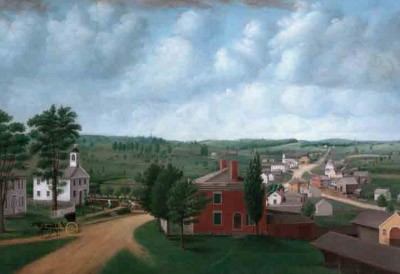
fig 1 - Robert Peckham, Westminster Village, 1831, oil on board, Forbush Memorial Library, Westminster, Massachusetts
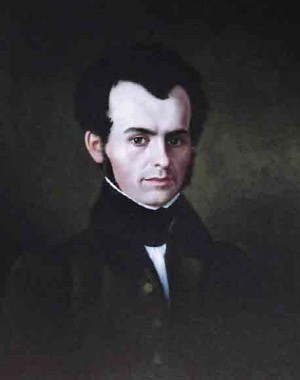
fig 2 - Robert Peckham, John Greenleaf Whittier, 1833, oil on canvas, John Greenleaf Whittier Homestead, Haverhill, Massachusetts
Very few of the more than 50 portraits believed to be by Peckham are signed or otherwise documented, so attributions necessarily have been made on the basis of style and geographic or familial connections. The Forbush Memorial Library in Westminster has 11 likenesses of Peckham’s neighbors and fellow townsmen that are similar to one another in execution and attributed to the artist by tradition and family history. Other works, such as Peckham’s portrait of the poet John Greenleaf Whittier (fig. 2), are documented through writings. Whittier, whom Peckham admired for his abolitionist convictions, posed for the artist in 1833, but later rather unkindly commented, “I only recall sitting for him two or three times, but how it looked I have no idea. If it was a good picture, it was a miracle, for the Deacon was eminently artless” (5).

fig 3 - Map of Massachusetts, Connecticut, and Rhode Island Constructed from the Latest Authorities. Published by S. Augustus Mitchell, Philadelphia, 1831, David Rumsey Historical Map Collection, Copyright © 2010 Cartography Associates
See below for detail of highlighted area showing Westminster and locations of Peckham's sitters.
Many stylistic characteristics of Whittier’s portrait—the strong, single-direction lighting emphasizing the subject’s shining forehead, to the fluid handling of the sitter’s hair, and the placement of highlights in his eyes—are found in unsigned works attributed to Peckham. While the artist’s style may have evolved somewhat over the years, his works are recognizable for their distinctive quality of hard light, their sometimes “too truthful” naturalism, their crispness, and their meticulous attention to detail. Peckham’s adult portraits are generally subdued (save for the colorful ribbons and jewelry of some female sitters) and are usually set against dark, featureless backgrounds. His relatively few portraits of children, however, are more colorful and complex with detailed interior settings. All of the children represented in these works lived within 50 miles of Westminster, several in directly adjacent towns (fig. 3). While the images make use of the same directional light, somewhat stiff poses, realistic (even unflattering) features, they are most arresting because of the direct gazes that connect subjects to viewer, their curious intensity, and the sense that the children are tightly enveloped within their environments.
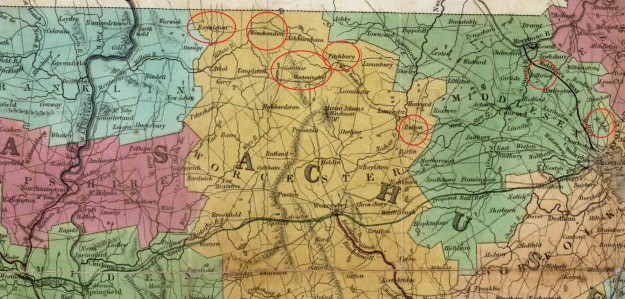
Peckham's portraits were created in an era in which child-rearing manuals, such as Lydia Maria Child’s The Mother’s Book (1831), Lydia Sigourney’s Letters to Mothers (1839), and Herman Humphrey’s Domestic Education (1840) admonished parents to attend to the supreme importance of the home. Mothers, especially, were entrusted with the shaping of their children’s moral and spiritual growth. The most effective training ground for such early instruction, it was felt, was the home—a haven from the potentially harmful influence of the outside world. In this same era, Bronson Alcott (1799–1888), a Massachusetts educator and transcendentalist, was observing and recording the behavior of his own children (including little Louisa May) (6). Believing in the innate innocence of childhood (a firm rejection of the Calvinist doctrine of original sin), Alcott was eager to discover when and how moral decision-making was established in the child and how the conscience took hold. In Peckham’s depictions of his young subjects, with their sympathetic but unromanticized demeanors, we see beings whose containment within a domestic interior reflects their purposeful, cosseted upbringing, and consciously or unconsciously echoes the growing internalization of their reasoning and conscience. At any time these children might be angelic or michevious, but in each case Peckham depicts them as specific individuals, rather than types (7).
Peckham’s forthright visual approach, in which everything before him is recorded with equal emphasis, situates him among those artists not academically trained. But his obvious command of texture and modeling and his strong sense of physiognomy distinguish him from most other naïve artists. His particular brand of realism and attention to the accoutrements of a well-appointed home appealed to local families at a time when their material fortunes were on the rise (8). In the early decades of the 19th century, small, primarily agricultural, towns were expanding their industries and growing in population and prosperity each year. An 1832 history of Westminster reported that straw bonnets, chairs, cooperware (barrels, tubs, pails), and window blinds were made in the town. The author also noted sawmills, gristmills, and workshops with turning lathes and a carding machine, located on the numerous streams in and around the village. Surprisingly, he concluded his description of “Agricultural and Manufactured Products” by relating that “Painting, of all kinds, including portrait painting, is here carried on to some extent” (9). Writing later in the century, William Heywood recalled the growth of chair making in the adjacent town of Gardner. Worcester County’s most important industry was governed by “the introduction of machinery into chair-shops, to be run with water or other power . . . the transition . . . may be regarded as having taken place substantially between the years 1830 and 1835, during which period the germs of most of the existing large chair establishments were first planted” (10).
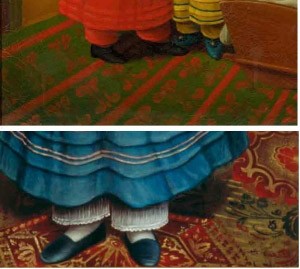
no. 1, detail (top); no. 5, detail (bottom)
The children Peckham depicted came from families that both created and enjoyed the burgeoning wealth of consumer goods in antebellum New England, a number of which are visible in his paintings. In some portraits the artist goes beyond naturalistic perspective, tilting the floors to better show busily patterned, colorful carpets. Probably ingrain carpets, which were then widely available, they show a variety of bold designs, as seen in The Children of Oliver Adams, Portrait of Rosa Heywood, The Raymond Children, The Farwell Children, and The Hobby Horse (11). Sometimes the carpets are paired with wallpaper in the background, which adds to the up-to-date character of the interior décor. Two of the portraits also include popular new lighting devices. The children are usually depicted in fine attire that would have been worn for special occasions rather than playing. However, play is alluded to in these works with the inclusion of dolls, pull toys, and a remarkable rocking horse. Parents who could afford such luxuries not only had the means but also the desire to extend their material good fortune to the younger generation.
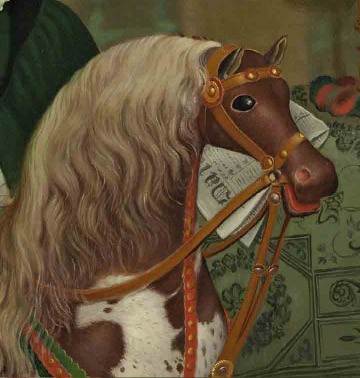
no. 9, detail
Of all the furnishings included in the interiors Peckham depicted, none is as striking as the hide-covered hobby horse for which the Gallery’s painting was named (12). The boy and girl in the portrait are unidentified and the artist was unknown when the work was purchased by Edgar William and Bernice Chrysler Garbisch, who later gave it to the National Gallery of Art (13). At the time the painting was made, around 1840 as judged by costumes and furnishings, no large manufacturers of rocking horses operated in the United States, although several major producers would arise in the next few decades. The steed in the painting provides no geographic or familial clues as to the identity of the children portrayed with it. This bow horse was likely produced by a skilled craftsman or craftsmen with English or German training. To create it, animal hide (probably calfskin) was stretched and sewn or tacked over an expertly carved wooden body. Real horsehair was applied to form the mane and tail, large glass eyes were inserted, the base and rockers decoratively painted and stenciled, and a colorful leather bridle attached. Although antique rocking horses are still commonly found, few of the age, beauty, and complexity of this example survive. Even in its time, it must have been a costly rarity (14).
Rocking horses of various types and small pull-toy horses are included in a number of 19th-century portraits of children and were used in popular illustrations. As early as 1785, an advertisement promoted the “wholesome exercise” to be gained from rocking horses. Most often it is boys who are shown with them in paintings. Even when they are not on horseback, young males are often depicted holding whips to suggest the control they were expected to master, equestrian or otherwise. Portraits of girls were more likely to include dolls, flowers, or other attributes of more passive pursuits (15). Peckham’s placement of the siblings in The Hobby Horse, with the sister standing by, may reflect the childrens' actual behavior, but it also recalls an image known from verse and illustrated on 19th-century ceramics presented as rewards to children (16). First published in London in 1812, Mary Belson (Elliott)’s verse read: “Who saw me mount the Rocking Horse/And stood by to check its course/Lest her dear boy should get a toss?/MY SISTER” (17). The words are accompanied by an illustration of a girl, arm outstretched in caution, standing beside her exuberant younger brother. Peckham may have known this verse and image, but he also most likely showed the sister in the Gallery’s painting grasping the horse’s rocker in order to tie the two figures to each other and to the extraordinary object dominating the composition. The boy’s central position emphasizes the societal importance of a male heir.
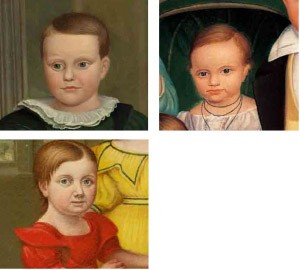
clockwise from top left: no. 9, detail; no. 6, detail; no.1, detail
Portraits preserved likenesses for posterity while adding refinement to the household. In an era of childhood mortality they could also be a means of capturing the appearance of a beloved child lost too soon. Peckham’s The Children of Oliver Adams and The Farwell Children each include an image of a child who had already died at the time the portrait was made. In The Hobby Horse, the boy’s sideways glance—disquieting and unusual in Peckham’s work—might suggest that he did not pose in front of the artist, perhaps having already departed this world. By the end of the 19th century many children were memorialized in photographs. At the moment when photography was introduced to the United States in 1839, Peckham and other portraitists competed with the quickly made but small and monochromatic daguerreotypes by producing vibrant, colorful likenesses in oil. Remarkable for their directness and immediacy, Peckham’s portraits preserve indelible images of children in 19th-century America.
Acknowledgments
The author would like to thank Nicholas Langhart, Margaret Howe-Soper, and Professor Karen Haney, in connection with the Forbush Memorial Library, Westminster. Information was also generously shared by folk art collector David Krashes and Peckham enthusiast Janice Peckham Wagner.
Notes
1. He was first researched and written about by local historians in his native town of Westminster, Massachusetts, and was later discussed in three journal articles. See histories by Bragdon and Howard, and articles by Johnson, Luckey, and Krashes in the Bibliography. A selection of paintings by Peckham was shown at the Fruitlands Museum, Harvard, Massachusetts, in the summer of 1983. No catalog or checklist of the exhibition exists.
2. See Chronology for details.
3. Georgia Brady Baumgardner, ”The Early Career of Ethan Allen Greenwood,” Itinerancy in New England (Boston, 1986).
4. The other social cause to which the artist was devoted was temperance. Peckham’s small panels The Woes of Liquor and The Happy Abstemious Family are in the collection of the Worcester (Massachusetts) Historical Museum.
5. John Greenleaf Whittier letter to Dr. Crowell, Houghton Library, Harvard University, Cambridge, Massachusetts. Quoted in Krashes 1996, p. 44
6. Charles Strickland, "A Transcendentalist Father: The Child-Rearing Practices of Bronson Alcott,” Perspectives in American History, vol. 3 (Cambridge, MA, 1969), 5–73.
7. Working in about the same years, but in New Jersey and Baltimore, Oliver Tarbell Eddy (1799–1868) created images of children in shadowy interiors that share the same directness and seriousness of Peckham’s portraits. Some intriguing images parallel to Peckham’s were created by Eliza Goodridge (1798–1887), a Worcester miniaturist. Her watercolors on ivory include remarkable interior details. See Lydia Stiles Foster (c .1838), The Foster Children (1838), and Mary Macarty Stiles (c. 1837) at the American Antiquarian Society, Worcester.
8. For a fascinating study of the New England economy at this time and a discussion of Peckham’s place in it, see David Jaffee, A New Nation of Goods: The Material Culture of Early America (Philadelphia, 2010). Jaffee notes that Worcester County’s population increased from 56,807 in 1790 to 95,313 in 1840 (192).
9. Charles Hudson, A History of the Town of Westminster (Mendon, MA, 1832). If there were portraitists in addition to Peckham working steadily in Westminster, they have not been identified.
10. William S. Heywood, Gardner & Westminster Historical Sketches (Boston, 1879).
11. Peckham is not alone in his emphasis of boldly patterned carpets as evidenced by the work Joseph Whiting Stock (1815–1855), Erastus Salisbury Field (1805–1900), and other American folk artists.
12. The term “hobby horse” is more conventionally applied to the toy that was a simple stick, for straddling, to which a horse-type head was attached. However, it can also describe a horse on rockers. Another meaning of the phrase is “a topic to which one constantly reverts.” This is perhaps an apt description of Deacon Peckham’s devotion to chosen social causes.
13. It was Dale Johnson (see Bibliography) who first proposed attributing The Hobby Horse to Peckham.
14. In addition to published sources such as Patricia Mullins, The Rocking Horse: A History of Moving Toy Horses (London, 1992), expertise was provided by longtime collector Dr. Edmund A. Weinberg and by rocking horse restorer Tony Stevenson (correspondence in author’s file). I would also like to acknowledge Richard C. Nylander, who called my attention to the hide-covered horse in the Society for the Preservation of New England Antiquities (now Historic New England) collection, and Margaret Konitzky (Historic New England), who arranged for me to see it. A similar horse, sold at Skinner, Inc., Sale 1274, October 27–28, 1989, is now unlocated.
15. For examples of this practice see tables 6, 7, and 19–23 in Jennifer A. Yunginger, Is She or Isn’t He? Identifying Gender in Folk Portraits of Children (Sandwich, MA, 1995).
16. Peckham included such ceramics, Staffordshire children’s mugs, in his portraits John Adams (1822), Mary Edgell (1830), and The Raymond Children (c. 1838, no.4).
17. Noel Riley, Gifts for Good Children: The History of Children’s China, Part I, 1790–1890 (Ilminster, Somerset, UK, 1991), nos. 74, 77, and 78 (32–35).
